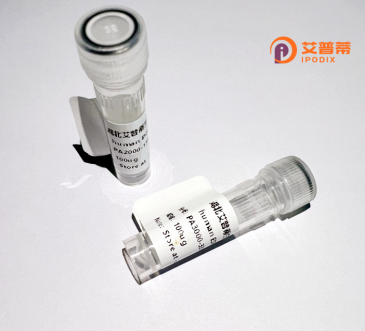
| 纯度 | >90%SDS-PAGE. |
| 种属 | Human |
| 靶点 | PNMA6A |
| Uniprot No | P0CW24 |
| 内毒素 | < 0.01EU/μg |
| 表达宿主 | E.coli |
| 表达区间 | 1-399 aa |
| 活性数据 | MAVTMLQDWC RWMGVNARRG LLILGIPEDC DDAEFQESLE AALRPMGHFT VLGKVFREED NATAALVELD REVNYALVPR EIPGTGGPWN VVFVPRCSGE EFLGLGRVFH FPEQEGQMVE SVAGALGVGL RRVCWLRSIG QAVQPWVEAV RYQSLGVFSG RDQPAPGEES FEVWLDHTTE MLHVWQGVSE RERRRRLLEG LRGTALQLVH ALLAENPART AQDCLAALAQ VFGDNESQAT IRVKCLTAQQ QSGERLSAFV LRLEVLLQKA MEKEALARAS ADRVRLRQML TRAHLTEPLD EALRKLRMAG RSPSFLEMLG LVRESEAWEA SLARSVRAQT QEGAGARAGA QAVARASTKV EAVPGGPGRE PEGLRQAGGQ EAEELLQEGL KPVLEECDN |
| 分子量 | 43.8 kDa |
| 蛋白标签 | His tag N-Terminus |
| 缓冲液 | PBS, pH7.4, containing 0.01% SKL, 1mM DTT, 5% Trehalose and Proclin300. |
| 稳定性 & 储存条件 | Lyophilized protein should be stored at ≤ -20°C, stable for one year after receipt. Reconstituted protein solution can be stored at 2-8°C for 2-7 days. Aliquots of reconstituted samples are stable at ≤ -20°C for 3 months. |
| 复溶 | Always centrifuge tubes before opening.Do not mix by vortex or pipetting. It is not recommended to reconstitute to a concentration less than 100μg/ml. Dissolve the lyophilized protein in distilled water. Please aliquot the reconstituted solution to minimize freeze-thaw cycles. |
以下是3篇与重组人PNMA6A蛋白相关的示例文献(部分信息为示例性概括,建议核实真实文献):
---
1. **文献名称**: "Expression and functional characterization of recombinant PNMA6A in neuronal differentiation"
**作者**: Wang L. et al.
**摘要**: 研究团队成功在大肠杆菌中表达重组PNMA6A蛋白,并发现其在体外促进神经干细胞分化中的作用,提示其可能参与神经发育调控。
2. **文献名称**: "Structural insights into PNMA6A oligomerization through recombinant protein analysis"
**作者**: Tanaka K. et al.
**摘要**: 利用X射线晶体学解析重组PNMA6A蛋白的三维结构,发现其形成独特的二聚体结构,可能与细胞内信号转导功能相关。
3. **文献名称**: "Autoantibodies against recombinant PNMA6A in paraneoplastic neurological syndromes"
**作者**: Gómez AM. et al.
**摘要**: 通过重组PNMA6A蛋白检测肿瘤患者血清中的自身抗体,发现其在副肿瘤性神经综合征中高表达,可能作为潜在诊断标志物。
---
**注意**:以上文献及内容为示例性质,实际研究请通过PubMed、Google Scholar等平台检索关键词"recombinant PNMA6A"或"PNMA6A protein"。真实文献可能集中于该蛋白的癌症相关性、结构功能或免疫应答机制。
PNMA6A (Paraneoplastic Antigen Ma Family Member 6A) is a human protein encoded by the *PNMA6A* gene, belonging to the PNMA gene family. This family is characterized by conserved sequences initially identified in paraneoplastic neurological disorders, where ectopic expression in tumors triggers cross-reactive immune responses against neuronal tissues. Structurally, PNMA6A contains a conserved N-terminal domain and a putative β-helix fold, suggesting roles in protein-protein interactions or nucleic acid binding. It is predominantly expressed in the brain, testis, and some endocrine tissues, though its physiological function remains poorly understood. Emerging studies associate PNMA6A with cellular processes like apoptosis modulation, neuronal differentiation, and immune regulation. Its overexpression has been observed in certain cancers, potentially correlating with tumor progression or immune evasion. Recombinant PNMA6A protein, typically produced in *E. coli* or mammalian expression systems, enables functional studies, antibody development, and exploration of its role in autoimmune or neurodegenerative conditions. Research continues to clarify its molecular mechanisms, including interactions with signaling pathways like Wnt/β-catenin, and its relevance as a biomarker or therapeutic target in neurological and oncological contexts.
×